How to Effectively Pressure Wash Your Wood Deck
- April 1, 2024
- 0 comment
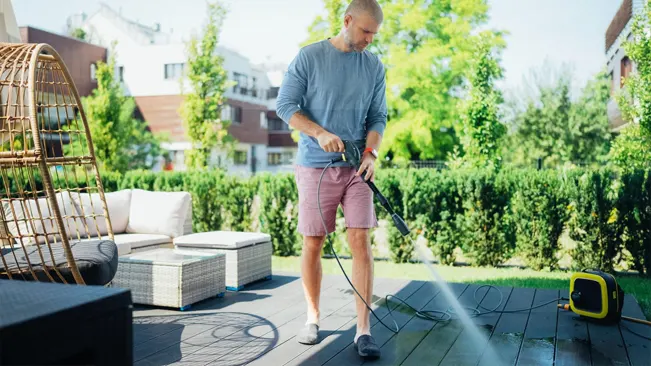
Learning how to effectively pressure wash your wood deck is key to restoring its beauty and extending its life. This process removes dirt, mildew, and graying caused by weathering, preparing the deck for sealing or staining. Proper pressure washing techniques ensure that the wood is cleaned thoroughly without causing damage to the deck’s surface.
It’s an environmentally friendly way to maintain your outdoor living space, often requiring no chemicals, just water at a high velocity. Regular pressure washing not only enhances curb appeal but also provides a safe, splinter-free surface for bare feet and family activities.
Effectively pressure washing your wood deck is important as it not only revives the deck’s appearance but also prevents decay by removing harmful substances like mold, mildew, and dirt. This maintenance task extends the life of the wood, ensuring the deck remains a safe and enjoyable outdoor space for years to come.
5 Essential Steps for Effectively Pressure Washing Your Wood Deck
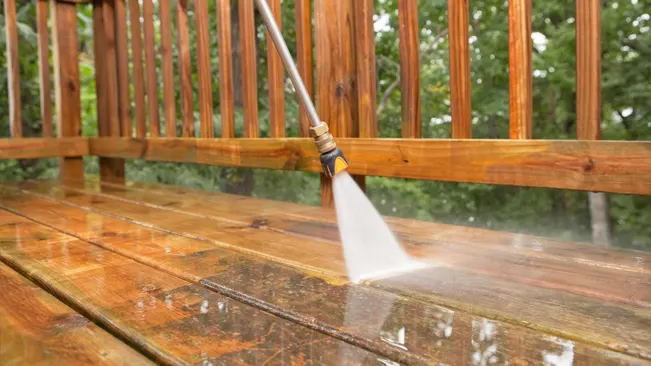
1. Preparing Your Deck for Pressure Washing: Safety Measures and Initial Steps
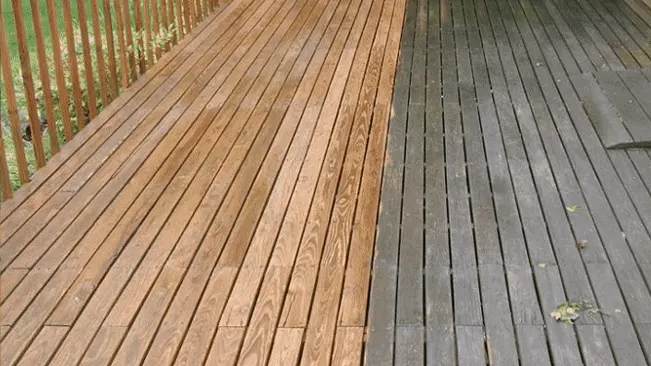
Preparing your deck for pressure washing is a critical first step, involving clearing, cleaning, and safeguarding the area and yourself to ensure a safe, effective cleaning process.
The importance of properly preparing your deck for pressure washing cannot be overstated, as it sets the foundation for a safe and efficient cleaning process. Clearing the deck of furniture and debris prevents accidents and ensures even cleaning, while protective measures like securing loose boards protect both the deck and the user. These initial steps, coupled with appropriate safety gear, not only enhance the effectiveness of the washing but also extend the life of your deck by preventing damage during the cleaning process.
Taking the time to inspect and repair any damage before starting ensures the high-pressure water doesn’t exacerbate existing issues, which can lead to costly repairs. Additionally, choosing the right cleaning solutions and pressure settings tailored to your deck’s material is crucial for preserving the integrity of the wood and achieving the best results.
4 Essential Steps to Prepare Your Deck for Safe and Effective Pressure Washing
- Remove All Objects: Clear the deck of furniture, grills, planters, and any other items to prevent damage and ensure an unobstructed workspace.
- Sweep and Inspect the Deck: Thoroughly sweep the deck to remove loose debris, dirt, and leaves, and inspect for any loose nails, screws, or boards that might need securing.
- Wear Protective Gear: Always wear safety goggles, gloves, and sturdy, non-slip shoes to protect yourself from the high-pressure water and any dislodged debris.
- Cover Sensitive Areas: Protect surrounding areas like plants, flowers, and exterior walls by covering them with tarps or plastic sheeting to prevent damage from the water spray.
2. Choosing the Right Pressure Washer and Settings for Wood Surfaces
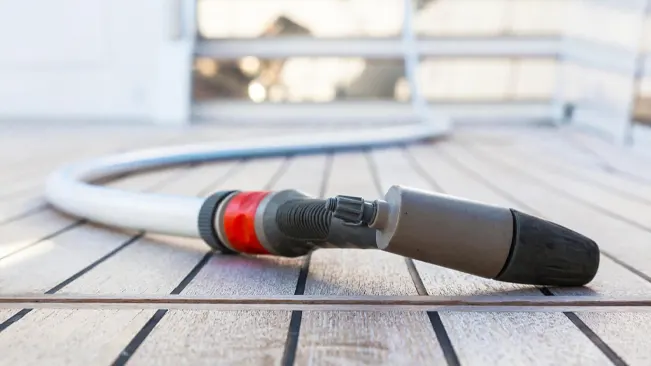
Selecting the right pressure washer and settings is pivotal for wood deck maintenance, balancing power and gentleness to clean effectively while preserving the integrity of the wood.
Selecting an appropriate pressure washer for your wood deck is vital; a washer with adjustable settings allows you to choose a lower pressure that cleans effectively without damaging the wood. Consider the washer’s PSI (pounds per square inch) and GPM (gallons per minute) ratings – for wood surfaces, a PSI of around 500-600 is usually sufficient. Additionally, choosing the right nozzle and distance from the surface is crucial to prevent splintering or gouging of the wood.
Using a nozzle that disperses water over a wider area helps distribute pressure more evenly and reduces the risk of wood damage. It’s also advisable to keep the nozzle moving in a consistent sweeping motion to avoid focusing the pressure on any single point, which can lead to marks or indentations in the decking.
Key Considerations for Selecting the Ideal Pressure Washer for Wood Surfaces
- Pressure Rating (PSI): Opt for a washer with a moderate PSI (around 500-1200), as high pressure can damage wood.
- Water Flow (GPM): Consider the gallons per minute, as higher GPM can mean more efficient cleaning without excessive pressure.
- Nozzle Type: Use a wider angle nozzle (such as 40-60 degrees) to disperse pressure and prevent wood damage.
- Detergent Usage: If using detergent, ensure it’s wood-friendly and suitable for use with your pressure washer model.
- Adjustable Settings: Choose a washer with adjustable pressure settings to customize the cleaning intensity based on the wood’s condition and dirt level.
3. Techniques for Effective Pressure Washing: Patterns and Angles for Best Results
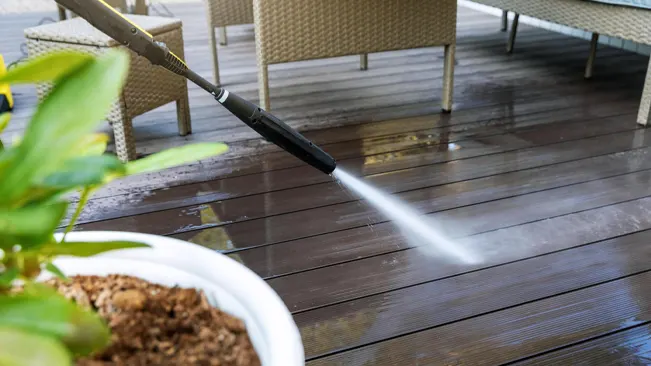
Mastering the right techniques for effective pressure washing involves understanding the ideal patterns and angles to achieve the best results without damaging surfaces. Skillful application is essential for efficient cleaning and maintaining the integrity of your deck.
Effective pressure washing techniques involve moving the spray in a consistent, sweeping motion, maintaining a steady distance to ensure uniform cleaning. Use a fan-like spray pattern to cover more surface area gently and prevent streaks. Holding the nozzle at a 45-degree angle helps in effectively lifting and removing dirt without damaging the wood.
It’s essential to overlap each stroke to avoid missed spots and ensure a thorough clean. Regular pauses to rinse away loosened debris can also aid in assessing the cleaning progress and adjusting techniques as needed to achieve the desired finish.
5 Key Techniques for Effective Pressure Washing
- Uniform Movement: Maintain a steady, sweeping motion for even cleaning without leaving streaks or marks.
- Optimal Angle Approach: Hold the nozzle at a 45-degree angle to effectively lift dirt without damaging the wood.
- Distance from Surface: Keep a consistent distance from the surface to avoid uneven cleaning and wood damage.
- Overlap Strokes: Slightly overlap each pass to ensure no areas are missed and to avoid visible lines.
- Pressure Adjustment: Modulate the pressure based on the dirtiness of the area and the wood’s condition, using lower pressure on more delicate surfaces.
4. Post-Washing Treatments: Drying, Sanding, and Sealing Your Deck
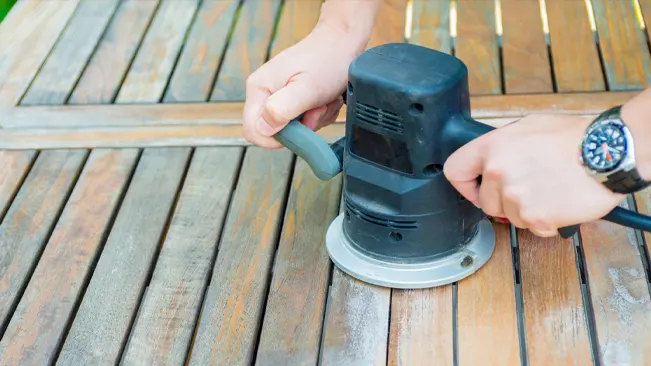
After pressure washing your deck, post-washing treatments such as drying, sanding, and sealing are crucial steps to ensure long-term protection and maintenance. These processes restore and enhance the wood’s natural beauty and resilience.
It’s important to let the deck dry completely, which could take a couple of days, depending on weather conditions. Once dry, sand any rough spots to create a smooth surface, and then apply a sealant to protect the wood from moisture and UV damage. This not only prolongs the deck’s lifespan but also enhances its appearance.
Applying the sealant in even, controlled strokes will ensure a consistent finish that repels water and resists weathering. Periodic maintenance, including cleaning and resealing the deck every few years, will keep the wood in prime condition and help to avoid the costly repairs that come from neglect.
5 Crucial Considerations for Post-Washing Deck Treatments: Ensuring Durability and Aesthetics
- Adequate Drying Time: Allow the deck to completely dry, which could take 24-48 hours, before proceeding with further treatments.
- Thorough Sanding: Sand any rough or raised areas to create a smooth surface, particularly important if the wood has become splintered after washing.
- Choice of Sealant: Select a high-quality sealant that suits your deck’s wood type and climate conditions, considering factors like UV protection and moisture resistance.
- Application Technique: Apply sealant evenly and according to the product’s instructions for optimal protection and appearance.
- Regular Inspection: Regularly check the deck post-treatment for any areas that may need touch-ups or reapplication, especially in high-traffic zones.
5. Maintenance Tips: Scheduling Regular Pressure Washing for Long-Term Deck Care

Maintaining your deck through regular pressure washing is key to its longevity and appearance. Scheduled cleanings prevent the buildup of grime and damage, ensuring the deck remains a safe and appealing extension of your home.
Regular maintenance, including periodic pressure washing, is essential to keep your deck in top condition. Schedule pressure washing at least once a year to prevent the buildup of dirt, algae, and mildew. Consistent upkeep, including checking for repairs and re-sealing as needed, will prolong the life of your deck and keep it looking great for years to come.
Monitoring the deck for any signs of wear and tear between cleanings can help you catch and address minor issues before they escalate. By committing to a regular maintenance routine, you not only preserve the deck’s aesthetics but also its safety and functionality.
5 Essential Maintenance Tips
- Frequency of Cleaning: Determine how often your deck needs pressure washing, typically once or twice a year, depending on exposure to elements and foot traffic.
- Seasonal Considerations: Plan pressure washing during favorable weather conditions, usually in spring or fall, to prepare the deck for extreme weather seasons.
- Inspecting for Damage: Regularly inspect your deck for signs of wear or damage such as loose boards or rot, which should be addressed before pressure washing.
- Pre-Wash Preparations: Before each pressure wash, ensure the deck is cleared and prepped, including checking for any loose nails or splinters.
- Post-Wash Care: After pressure washing, follow up with necessary treatments like sealing or staining to protect the wood and maintain its aesthetic appeal.
Conclusion
Effectively pressure washing your wood deck is a vital component of home maintenance, ensuring both aesthetic appeal and structural integrity. By carefully selecting the right equipment, employing proper techniques, and following through with essential post-wash care, you can significantly extend the life of your deck. Regular maintenance, coupled with these effective pressure washing practices, will keep your outdoor space looking its best and ready for years of enjoyment.
FAQs
1. Why is pressure washing important for wood decks?
Pressure washing is crucial for maintaining a wood deck’s beauty and longevity. It removes dirt, mildew, and weathering graying, preparing the deck for sealing or staining. This maintenance task not only revives the deck’s appearance but also prevents decay by eliminating harmful substances like mold and mildew.
2. How do I prepare my deck for pressure washing?
Preparing your deck involves removing all furniture and objects, sweeping away debris, wearing protective gear, and covering sensitive areas. Inspecting and repairing any damage before washing is also important to prevent the high-pressure water from worsening existing issues.
3. What pressure washer settings are best for wood decks?
For wood surfaces, a moderate PSI (around 500-1200) is recommended to clean effectively without damaging the wood. Use a wider angle nozzle (40-60 degrees) to disperse pressure evenly and prevent wood damage. Adjustable settings allow customization based on the wood’s condition and dirt level.
4. What are the best techniques for pressure washing a wood deck?
Effective techniques include maintaining a uniform sweeping motion, holding the nozzle at a 45-degree angle, keeping a consistent distance from the surface, overlapping strokes, and adjusting pressure based on the area’s dirtiness and wood condition.
5. What should I do after pressure washing my deck?
Post-washing treatments include allowing the deck to dry completely, sanding rough spots, and applying a sealant to protect against moisture and UV damage. This enhances the deck’s appearance and prolongs its lifespan.
6. How often should I pressure wash my wood deck?
Regular maintenance, including pressure washing, should occur at least once a year to prevent dirt, algae, and mildew buildup. The frequency can vary based on the deck’s exposure to elements and foot traffic.
7. Can I pressure wash my deck in any season?
Pressure washing is best done during favorable weather conditions, typically in spring or fall, to prepare the deck for extreme weather seasons. Avoid washing in freezing temperatures or during rainy periods.
8. Do I need to use detergent when pressure washing a deck?
While pressure washing with just water is environmentally friendly and often sufficient, using a wood-friendly detergent can enhance cleaning, especially for stubborn stains or areas with significant mold or mildew growth.
9. How do I protect my plants and exterior walls when pressure washing?
Protect plants, flowers, and exterior walls by covering them with tarps or plastic sheeting. This prevents damage from the water spray and any cleaning solutions used.
10. What safety precautions should I take when pressure washing?
Wear safety goggles, gloves, and sturdy, non-slip shoes to protect against the high-pressure water and any dislodged debris. Ensure the area is clear of obstacles and secure any loose deck boards to prevent accidents.

Charles Hayes
Forestry AuthorI'm Charles Hayes, I bring over 15 years of specialized expertise in landscaping and woodworking, blending artistic design with sustainable environmental stewardship. My career, fueled by a profound passion for the natural world, encompasses extensive education and hands-on experience in creating harmonious, eco-friendly outdoor spaces and responsibly managing forest resources. Recognized for my professional standing, I am committed to continuous learning and certification in cutting-edge practices. My expertise is not only reflected in my work but also in my contributions to community projects, educational workshops, and collaborations with industry leaders. As an authoritative voice in my field, I strive to share knowledge and promote environmentally conscious approaches, making me a trusted resource in landscaping and forestry.













Leave your comment